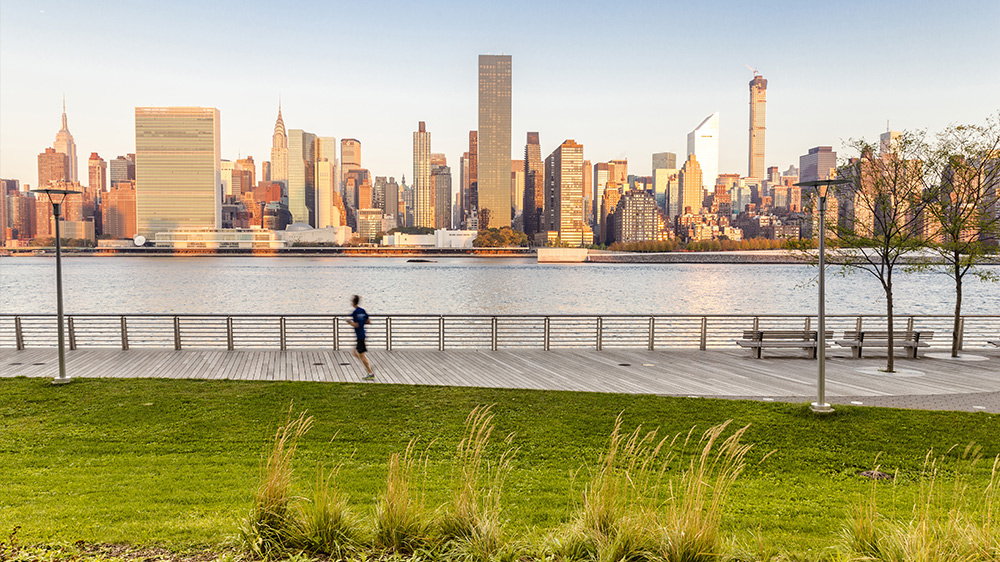From green space to traffic volume, the neighborhood in which you live could contribute to your health. Think about it: If your neighborhood lacks easily accessible areas for you to exercise, you’ll probably exercise less, at least outdoors. Just as the addition of playgrounds gives children a place to play, sidewalks, for example, can encourage you to get out and walk. And when you do spend time outside in your neighborhood, you’re more likely to get to know your neighbors, which adds to a feeling of community. So whether you’re shopping for a home for sale in Denver, CO, or Columbia, SC, here are some factors to weigh if a healthy neighborhood tops your list of must-haves.
1. Look for sidewalks and bike lanes
Being able to walk or bike for exercise or to conduct daily errands is good for you — plus, less traffic and air pollution means a healthier planet too. Even having access to public transportation can contribute to a healthy lifestyle, since there’s usually some walking to get to your bus stop or train station. “Safety and walkability to a vibrant mix of services, schools, and various modes of travel are keys,” says John Zinner, a Leadership in Energy and Environmental Design Fellow with the U.S. Green Building Council.
2. Don’t underestimate a lush tree canopy
New developments often produce houses that dot every “i” and cross every “t” on most people’s home wish lists. But some new neighborhoods and developments end up with a sparse tree canopy. That’s too bad, because not only do trees often enhance property values, but they can also contribute to a healthy neighborhood. “Tree canopies cool spaces,” says Cassy Aoyagi, president of FormLA Landscaping, a California sustainable-landscaping firm. A cooler lot means your HVAC system doesn’t have to work as hard in the heat of summer. Those trees can also provide shade for your outdoor pursuits. But the best part just might be that greenery in general is good for you. “Lush, green spaces have been shown to decrease stress, even mitigating symptoms of PTSD and ADHD,” Aoyagi says.
3. Look for neighborhoods with greenways, community gardens, and trails
The more access you have to nature — and nature’s bounty — the healthier you’ll probably be. “Locating a healthy neighborhood has increasingly become a must-have for many buyers,” says Danielle Schlesier, a Boston, MA, agent. “I point [buyers] toward the community parks-and-recreation website. There, they can see if there are local farmers markets, community fitness programs, greenway trail maps, and dog parks available.” Another great tool to locate your favorite healthy amenities is the Live Well layer in Trulia Maps.
4. Observe neighborhood social connections and activity level
Having a sense of security and even happiness comes with being able to socialize with your neighbors. Visit the neighborhood you’re considering at various times of day to see if people are out and about. Are neighbors chatting out front? Jogging on neighborhood streets? Out walking their dogs or playing with the kids? All of these are positive signs that a neighborhood has a thriving, active, and close-knit community.
5. Scout out parks, sports courts, and places to play
The healthiest neighborhoods offer variety and versatility when it comes to recreation and active living. In addition to nature exploration resources like trails and greenways, look for neighborhoods that offer tennis or basketball courts, playgrounds, parks, fitness centers, and pools. You may have to pay for these extra amenities through homeowners’ association (HOA) fees, membership requirements, or simply higher home prices, but the ability to easily diversify your workouts can lead to greater health and fitness.
6. Go to a neighborhood association meeting
Mark your calendar for the next meeting of the neighborhood association or HOA in the areas you’re considering. In addition to meeting your potential neighbors, you could get an inside look at neighborhood concerns (such as safety issues or traffic congestion) and find out about future construction or plans for enhancements. You’ll also get a sense of how close-knit the community is. An active, positive group of neighbors working to continually improve their neighborhood can clue you in on future healthy upgrades coming to a neighborhood. Plus, if you’re trying to narrow down your options, going to a few of these meetings could help you decide where you’ll really feel at home.
7. Consider traffic volume
Limited traffic, both in volume and speed, can contribute to a healthy neighborhood. But what makes high traffic unhealthy, exactly? Noise, for one. The more traffic there is and the faster cars travel, the noisier the environment, which can affect your sleep and stress levels. There’s that pesky little pollution issue, for another. Plus, longer commutes due to higher traffic volumes can decrease your overall quality of life. Check what your possible commute could look like using the Commute layer in Trulia Maps.
8. Check to see if healthy essentials are within walking distance
Healthy neighborhoods incorporate plenty of ways to be active, but they also have essential services nearby, such as day care centers, pharmacies, doctors’ offices, a hospital, and urgent care. Easy access to affordable, nutritious food from supermarkets or farmers markets is important too — it’s even been associated with less obesity. And give your future new neighborhood bonus points if any of these essentials are within walking distance!


